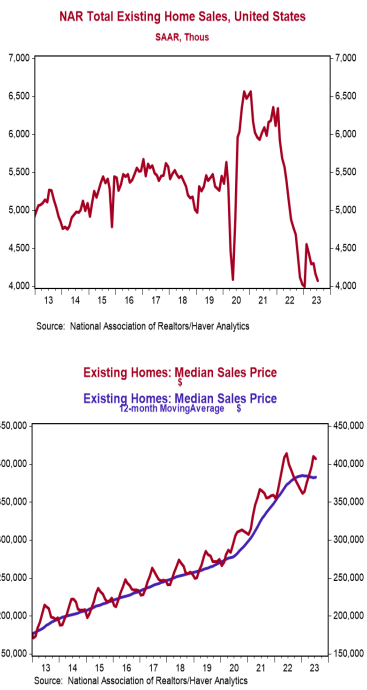- Existing home sales declined 2.2% in July to a 4.070 million annual rate, lagging the consensus expected 4.150 million. Sales are down 16.6% versus a year ago.
- Sales in July fell in the Northeast, Midwest, and South, but rose in the West. The drop in July was due to both single-family homes and condos/co-ops.
- The median price of an existing home declined to $406,700 in July (not seasonally adjusted) but is up 1.9% versus a year ago.
Implications:
Existing home sales data continued to look choppy in July, falling for the second month in a row to sit just above the low set back in January. It looks like the small rebound in sales from earlier this year has mostly reversed itself due to the housing market facing a series of crosswinds. First, the recent surge in benchmark interest rates like the 10- year Treasury yield has translated into 30-year fixed mortgage rates as well, which are currently hovering above 7.5% for the first time in over two decades. Assuming a 20% down payment, the rise in mortgage rates since the Federal Reserve began its current tightening cycle in March 2022 amounts to a 39% increase in monthly payments on a new 30-year mortgage for the median existing home. The shock of higher financing costs on non-homeowners (potential buyers) meant a short-term reduction in sales in 2022; but that negative impact should be diminishing as people adapt to a higher level of rates. While financing costs remain a burden, the good news for prospective buyers is that median prices have barely budged in the past year, which means buyers are no longer getting squeezed on both ends. However, many existing homeowners will be reluctant to sell due to a “mortgage lock-in” phenomenon, after buying or refinancing at much lower rates before 2022. That should limit future existing sales (and inventories). While we expect a continued moderation in national listing prices, a tight inventory of existing homes should prevent a repeat of 2008. Case in point, the months’ supply of homes (how long it would take to sell existing inventory at the current very slow sales pace) was 3.3 in July, well below the benchmark of 5.0 that the National Association of Realtors uses to denote a normal market. Finally, a weakening economy in which the Federal Reserve doesn’t act quickly to cut rates, because of high inflation, could be a headwind for home sales later this year. On top of this, new fee changes that went into effect May 1st as part of the Federal Housing Finance Agency’s push for affordable housing will effectively subsidize homebuyers and refinancers with riskier credit ratings by charging higher fees to those with good credit scores. These changes are likely to cause extreme confusion and result in pricier monthly mortgage payments for most homebuyers. Adding this altogether, expect sales and prices to drag on in the year ahead, with no persistent recovery in existing home sales until at least late 2023 or early 2024. In recent manufacturing news this morning, the Richmond Fed index, a measure of mid-Atlantic factory activity, rose to -7.0 in August from -9.0 in July, continuing to signal contraction.





